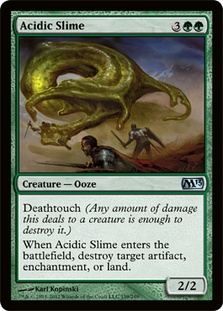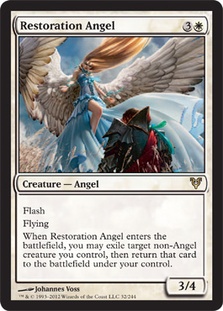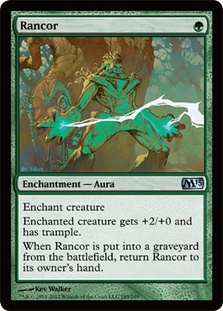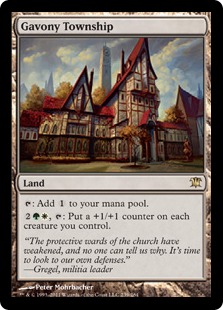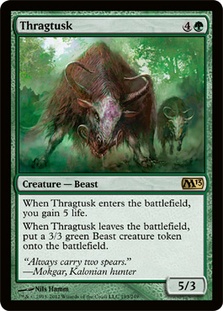About a week ago, I headed up to SCG Open Series: Buffalo with my buddy Max Brown. Now most of you probably don’t know Max, and even if you do, you might not know the real Max Brown, so let me give you a brief background on Max. Max is an 8-year-old kid trapped in a 24-year-old man’s body who has a heart of gold. His attitude towards Magic is great because no matter how he places in the tournament, he is happy as long as he played well and had a good time. He loves to play creature decks and cooks naked. I’m not really sure what him cooking naked has to do with anything, but I figured I’d throw that in. With that said, Max along with the help of Reid Duke and Matt Costa brewed up an awesome W/G deck that Max took to a Top 8 finish.
I would say that I helped too, but that may be giving myself too much credit since most of my suggestions were the opposite of what Max wanted to do with the deck. His plan of attack was to build a deck that was as fast as possible and could win on turn 4 with the help of Ajani, a card that until now hasn’t seen much play. He decided to go away from cards like Sword of War and Peace because in a deck like this you want to develop your board with creatures then push through with the more efficient and still powerful rancor. Before I go any further, I will post Max’s deck that he played at the SCG Standard Open in Buffalo.
Creatures (28)
- 4 Birds of Paradise
- 4 Hero of Bladehold
- 4 Blade Splicer
- 4 Avacyn's Pilgrim
- 3 Strangleroot Geist
- 4 Thalia, Guardian of Thraben
- 3 Restoration Angel
- 2 Silverblade Paladin
Planeswalkers (3)
Lands (23)
Spells (6)

After ten rounds of play, Max and I discussed his list and decided to make a few changes. We decided that even though Delver is still one of the top decks and Thalia, Guardian of Thraben is great against it, having four is a bit too many as it is a legend and you often want to skip over your two-drop, since you have eight one-mana accelerators and would prefer to play a three-drop in the form of Blade splicer or Ajani on turn 2 instead of Thalia.
Speaking of three-drops, Mirran Crusader is a powerhouse, and Max wanted to move them from the sideboard to the maindeck since Naya Pod, G/R Aggro, and black control decks have been on the rise. It is unfortunate that you cannot place a Rancor on it, but once you play a few games with the deck you will realize that it doesn’t matter all that much since you will almost always have a target for Rancor anyway. With the addition of Mirran Crusader, Silverblade Paladin got the boot; more often than not it just didn’t do enough. The last change to the maindeck was a number swap between Hero of Bladehold and Restoration Angel. I’ll talk about this change more later, but basically Hero is great against all non-Delver decks and Restoration Angel is better against Delver decks and slightly worse against the rest of the field.
The final list after changes is as followed.
Creatures (28)
- 4 Birds of Paradise
- 3 Mirran Crusader
- 3 Hero of Bladehold
- 4 Blade Splicer
- 4 Avacyn's Pilgrim
- 3 Strangleroot Geist
- 3 Thalia, Guardian of Thraben
- 4 Restoration Angel
Planeswalkers (3)
Lands (23)
Spells (6)

The Maindeck
Creatures
4 Avacyn’s Pilgrim / 4 Birds of Paradise – The deck is super reliant on its one-mana accelerators as the deck’s main goal is to drop as many creatures on to the board as fast as possible. Curving out with a turn 2 Blade Splicer followed by a turn 3 Hero of Bladehold can be a huge problem for most decks to deal with. What is also nice in this deck is that both the Pilgrim and Bird can get in there for damage with the help of Rancor, Ajani, Caller of the Pride, Hero of Bladehold and Gavony Township, which all power them up and turn them into threats. After board, both creatures can wear a Sword and bird can even help you cast your Gut Shots and Act of Treason without taking too much damage.
4 Blade Splicer – Blade Splicer is a powerhouse, and even more so in this deck since it puts two threats into to play. In most other decks it is not as relevant because here we have cards like Rancor, Gavony Township, Ajani, Caller of the Pride, and Hero of Bladehold that will add more pressure to your side of the table. Blade Splicer also combos well obviously with Restoration Angel. Blade Splicer is a card you should rarely sideboard out and playing four seems to be the right number in a deck like this.
3 Hero of Bladehold – The original list had four, but since Delver is still one of the most popular decks Hero fell down to only three copies for a few reasons. The first reason is that even though it is a powerhouse, Hero often enough just gets Vapor Snagged over and over again. Another reason why one Hero was dropped is because Restoration Angel is one of your best cards against Delver and you don’t want to four-drop slot to be clogged as it’s better to keep your curve as low as possible. Against nearly every other deck, Hero is your most powerful card as most decks can’t handle the fast damage it spits out. Hero plus Angel works as a combo as well since most decks will have to gang block the Hero and when they do you can just Blink it out before damage, then attack next turn and make more guys. If your metagame doesn’t have much Delver in it I can see playing four; otherwise three is a good number.
4 Restoration Angel – Restoration Angel, as I mentioned before, truly shines against Delver. It makes it harder for them to control the game since Angel can come down at any time. Restoration Angel also blocks all of their creatures, so them trying to tempo you out rarely works since they are the one who is often on the back foot. After board, Angel combos with Thragtusk and Acidic Slime to give you massive card advantage against certain decks that mostly cannot come back from it. A timely Acidic Slime against Wolf Run Ramp or Esper Control followed by an Angel can often be game. Angel combos with all of the above plus Blade Splicer by going turn 2 Blade Splicer, turn 3 Angel, which is just one of the best starts you can have in Standard.
3 Mirran Crusader – As I mentioned above, Mirran Crusader is the newest addition to the maindeck with the reason being that Pod decks and G/R Aggro are becoming more and more popular. Even though you can’t Rancor up a Crusader, putting a +1+1 counter on him with an Ajani is great since Crusader already has double strike. He also fills out the curve nicely since dropping him on turn 2 or a Blade Splicer is what you want to be doing with this deck. Against non-green or black decks this is the first card you want to cut when side boarding, but that doesn’t take anything away from how powerful he is.
3 Strangleroot Geist – Strangleroot Geist is a card that is seeing less play nowadays since most Pod decks have cut him in favor of Elvish Visionary. That may be correct for the Pod decks, but for a deck like this having access to Strangleroot Geist is great. If you don’t have a three-drop after a turn 1 Bird, a common turn 2 play with this deck is Strangleroot Geist, put a Rancor on it, then attack for four. Even if they have a removal spell for it you gain card advantage since both the Rancor and Geist come back. Just remember that if you put a +1+1 counter on Geist with Ajani it will not come back, but that shouldn’t be much of a problem since your deck has a swarm of creatures so you should have other creatures to power up.
3 Thalia, Guardian of Thraben – Thalia is great in the deck since it’s another aggressive creature, but also because you only have nine noncreature spells in the deck so Thalia’s effect won’t really slow you down while hurting your opponent’s development to the board. Thalia is best against Delver, Ramp, or Esper Control decks since forcing them to spend an extra mana on a board sweeper effect is often enough to bring them low enough that any follow up after it could be enough to get the game. Originally the list had four copies of Thalia, but since it’s a legend I would only run three. Against heavy creature decks you will probably want to side it out in favor of Thragtusks and Gut Shots.
Noncreature Spells
4 Rancor – The card that got everyone pumped up when it was spoiled in M13. Rancor is a classic that was placed on River Boas back in the day, but now it pretty much goes on anything. When you play this deck you will realize how good the card really is. Sure, there is Vapor Snag in the format, but that’s about it and even then it’s only a one for one. Other than the obvious don’t forget to return Rancor to your hand and to assign the proper amount of trample damage, remember that you can target your opponent’s Phantasmal Image with Rancor to kill it. Rancor is very important to the deck, and I wouldn’t play any less than four. You could, however, side some out against Delver in favor of Gut Shots. Gut Shot is important in stopping an early Delver, but it’s even more important when you can take out a Blade Splicer midcombat to remove first strike from their Golem. Since most of your guys have first strike, lots of times they will make a block assuming a trade will happen, but then a timely Gut Shot will ruin their plan.
3 Ajani, Caller of the Pride – Ajani is a card that is definitely underplayed right now, and I’m not just talking about Standard. As a three-mana costed planeswalker, Ajani is on the same power level as Liliana of the Veil, which has seen play in Legacy and Modern. In this deck Ajani is so good because it is an aggressive planeswalker and this deck, as you can see, is very aggressive. Most of the time when you drop an Ajani you will +1 it to put a counter on one of your guys. However, don’t be afraid to -3 it to get in a bunch of damage while your opponent is tapped out, and since it starts with four counters it will still be around to pump up your guys next turn.
You want to make sure you get down Ajani has quickly as possible because you can also just ultimate it and make a bunch of 2/2s. With that said, if you have the option to drop a turn 2 Blade Splicer or a turn 2 Ajani, I would lean towards Ajani almost every time.
2 Dismember – Dismember is the removal spell you want in this deck just because it’s much cheaper than Oblivion Ring and green and white doesn’t really have any more options. On one hand, Oblivion Ring can handle things like Birthing Pod or a Sword, but the deck doesn’t really care about permanents that don’t get in your way. Since Dismember can take out pretty much anything besides a Titan or Wurmcoil Engine, it is almost a must for the deck. Also, it is super good at taking out a Restoration Angel against Delver or opposing Pod decks that might try to get a flyer in the way of one of your lethal attacks with an Ajani boost. On top of that, the life loss often is not relevant, and if it is you can always use your Birds to add black mana.
The Lands
The lands are pretty straightforward with the deck having access to duals and Cavern of Souls to fix any color issues. It also runs Gavony Township, which is one of your best weapons in a creature matchup. Lots of times you will be way ahead in the game, then if your opponent starts to stabilize you can take a turn or two to pump up your guys and swarm in for the win. 23 land + eight mana creatures gives you more than enough mana to use your Townships and play out your threats without stumbling on your turns since you want to curve out smoothly.
So there you have it: the full breakdown of possibly one of the simplest decks in the current format. Play guys, attack, and win!
Now let’s take a look at our sideboard choices and when we might want to bring in certain cards.
The Sideboard
2 Sword of Feast and Famine – Mostly there for ramp, black, or control decks, but they should also be brought in against G/R Aggro and some Pod decks.
2 Acidic Slime – I talked about Slime before and how good the interaction is with Restoration Angel. Slime comes in against control and Pod decks. Killing a Pod is not on your list of priorities; however, it is also nice to have the option to do so.
2 Thragtusk – Truly shines against any aggressive deck but is also really strong against Delver since they most likely won’t have a good answer to it.
2 Celestial Purge – This might be overkill since Mono Red isn’t anywhere in the metagame and your matchup against Zombies is very good. Between Mirran Crusader and a bunch of hard to kill guys that you have maindeck, purge might not be needed, but for now having two seems fine.
3 Crushing Vines – One of your best weapons against Delver or any Trading Post type deck. However, they are not that great against Pod decks and you should only sideboard in one against them. As I mentioned before, the card Birthing Pod is not very good against you as it doesn’t immediately stop your swarm of guys. Other than that, it can only really kill either a Restoration Angel or Metamorph. So it is fine to bring in, but I wouldn’t want more than one.
2 Gut Shot – Great against other decks that are reliant on mana producers and good against Delver to take out Delver and Blade Splicer, as I mentioned earlier.
2 Act of Treason -Solid card in many different spots. It mostly shines against Wolf Run Ramp but is also good in other spots against a variety of decks.
This is a simple, fun deck that attacks the metagame from a different angle. If you want to give this deck a try, do so and feel free to message me with your results or any further questions about the deck.
Thanks for reading,
Gerard Fabiano

